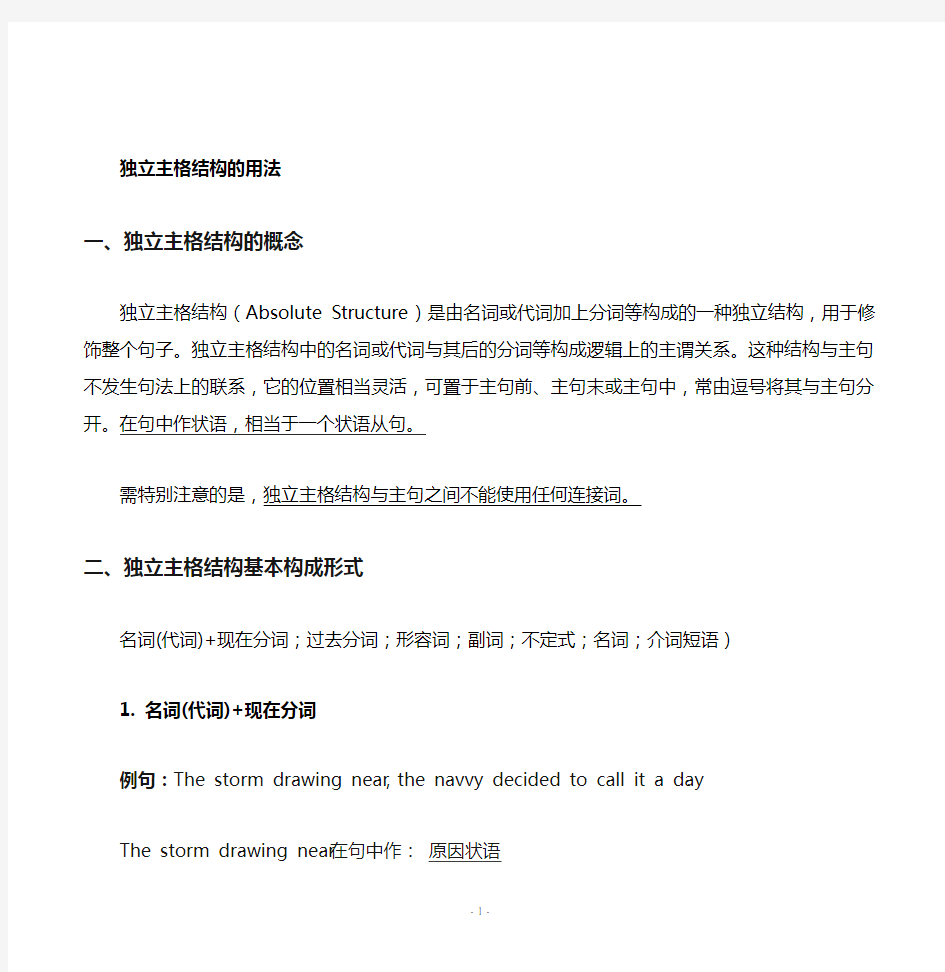

独立主格结构的用法
一、独立主格结构的概念
独立主格结构(Absolute Structure)是由名词或代词加上分词等构成的一种独立结构,用于修饰整个句子。独立主格结构中的名词或代词与其后的分词等构成逻辑上的主谓关系。这种结构与主句不发生句法上的联系,它的位置相当灵活,可置于主句前、主句末或主句中,常由逗号将其与主句分开。在句中作状语,相当于一个状语从句。
需特别注意的是,独立主格结构与主句之间不能使用任何连接词。
二、独立主格结构基本构成形式
名词(代词)+现在分词;过去分词;形容词;副词;不定式;名词;介词短语)
1. 名词(代词)+现在分词
例句:The storm drawing near,the navvy decided to call it a day.
The storm drawing near在句中作:原因状语
=Since the storm was drawing near,the navvy decided to call it a day.
由于暴风雨即将来临,那个挖土小工决定收工。(call it a day 今天到此为止)
例句:Winter coming, it gets colder and colder.
Winter coming在句中作:伴随状语
= The winter comes, and it gets colder and colder.
冬天来了,天气越来越冷了。
造句:时间允许的话,我就和你一起走。
Time permitting, I will go with you. 独立主格作:条件状语
=改写:If time permits, I will go with you.
造句:那个姑娘望着他,他不知道说什么好。
The girl staring at him, he didn’t know what to say.
独立主格作:时间状语
=改写:As the girl stared at him, he didn’t know what to say.
2. 名词(代词)+过去分词
例句:He was listening attentively in class, his eyes fixed on the blackboard.
他上课专心听讲,眼睛紧盯着黑板。
例句:The meeting gone over, everyone tired to go home earlier.
会议结束后,每个人都想早点回家。
造句:工作完成后,他回家了。
The work done, he went back home.
= When the work was done, he went back home.
3. 名词(代词)+不定式
在“名词/代词+动词不定式”结构中,动词不定式和它前面的名词或代词如果存在着逻辑上的主谓关系,动词不定式则用主动的形式;如果是动宾关系,则用被动形式。
例句:The four of us agreed on a division of labor, each to translate a quarter of the book.
我们四人同意分工干,每人翻译全书的四分之一。
例句:Many trees, flowers, and grass to be planted, our school will look even more beautiful.
种上许多的树、花和草后,我们新建的学校看上去将更美。
造句:还有很多作业要做,我不能和你走。
A lot of home work to do, I can’t go with you.
4. 名词(代词)+形容词
Computers very small, we can use them widely.
电脑虽小,我们却能广泛地利用它们。
he stood silent in the noon sunlight, its door open.
5. 名词(代词)+副词
The meeting over, our headmaster soon left the meeting room.
散会了,校长很快就离开了会议室。
灯熄了,我们不能继续工作了。
造句:The lights off, we could not go on with the work.
6. 名词(代词)+名词
His first shot failure,he fired again.
他第一枪没击中,又打了一枪。
Two hundred people died in the accident, many of them children.
两百人死于事故,其中有许多儿童。
7. 名词(代词) +介词短语
The huntsman entered the forest, gun in hand.
那位猎人手里提着枪走进了树林。
三、with,without 引导的独立主格结构
with ( without)+宾语(名词/代词)+宾语补足语,宾语通常由名词或代词充当,但代词一定要用宾格。上文的独立主格结构的几种情况都适用于此结构。
The girl hid her box without anyone knowing where it was.
小女孩把盒子藏了起来,没有人知道它在哪里。
(without +名词/代词+动词的-ing形式)
Without a word more spoken, she left the meeting room.
她没再说什么话就离开了会议室。(without+名词/代词+动词的-ed形式)The kid feels excited with so many places of interest to visit.
有这么多的名胜可参观,小孩很激动。(with+名词/代词+动词不定式) The boy was walking, with his father ahead.
父亲在前,小孩在后走着。(with+名词/代词+副词)
He stood at the door, with a computer in his hand. 或He stood at the door, computer in hand.
他站在门口,手里拿着一部电脑。(with+名词/代词+介词短语)
With his son so disappointing, the old man felt unhappy.
由于儿子如此令人失望,老人感到很不快乐。(with+名词/代词+形容词)在with (without) 的复合结构中,多数情况下with 能省略,但without 不能省略。
造句:老师走进教室,胳膊下面夹了一本书。
The teacher walked into the classroom, with a book under his arm.
造句:老师坐在椅子上,周围一群学生围着他。
The teacher is sitting in the chair, with a group of students around him
造句:工作完成了,他回家了。
With the work done, he went back home.
造句:由那个男孩带路,我们很容易就找到了那奇怪的洞。
With the boy leading the way, we had no trouble finding the strange cave.
四、独立主格结构的句法功能
独立主格结构在句中一般作状语,表示时间、条件、原因、伴随状况等,还可以作定语。
1. 作时间状语
My shoes removed,I entered a low-ceilinged room,treading cautiously on the soft tatami matting.
我脱掉鞋子后,走进一间屋顶很低的房间,小心翼翼地踩在柔软的塌塌米垫子上。
The governor pondering the matter,more strikers gathered across his path.
总督思考问题时,更多的罢工工人聚集在他要通过的路上。
2. 作条件状语
Weather permitting,they will go on an outing to the beach tomorrow.如果天气允许的话,他们将在明天组织一次海滨郊游。
Such being the case,you have no grounds for dismissing him.如果情况如此的话,你没有理由解聘他。
3. 作原因状语
The boy leading the way, we had no trouble finding the strange cave.
由那个男孩带路,我们很容易就找到了那奇怪的洞。
There being no further business to discuss, we all went home.
没有别的事可讨论,我们都回家了。
4. 作伴随状语或补充说明
I took my ticket,and marched proudly up the platform,with my cheeses,the people falling back respectfully on either side.
我拿着车票还有我的奶酪,雄赳赳气昂昂地跨步走向月台。人们似乎很尊敬我,纷纷向两边退去。
Ten students entered for the competition, the youngest a boy of 12.
十个学生报名参加了这次竞赛,年纪最小的是个12岁的男孩。
五、独立主格结构的特殊用法
1、有些分词短语可以独立存在,在句子中没有逻辑上的主语,实际上已经变成了习惯用法。这些短语有:
Generally speaking 总的说来, Frankly speaking 坦率地说,
Judging from 从……判断, Supposing 假设,等等。
①Generally speaking, the rule is very easy to understand.
总的说来,这条规则很容易懂。
②Judging from what he said, he must be an honest man.
由他所说的来判断,他一定是一个诚实的人。
2、有些固定短语是带to 的不定式,表明说话人的立场或态度,在句中作独立成分。这些短语有: to be honest老实说,to be sure 确实,to tell you the truth 说实话,to cut a long story short 长话短说,to be frank 坦率地说,to make matters / things worse 更糟糕的是,等等。
① To tell you the truth, I made a mistake in the word spelling.
说实话,我犯了一个拼写错误。
1.The lecture__c___,he left his seat so quietly that no one complained that his leaving disturbed the speaker.
A.began B.beginning C.having begun D.being beginning
2.Such__a___the case ,there are no grounds to justify your complaints.A.being B.is C.was D.to be
3.With all factors__c___,we think this program may excel(胜出)all the others in achieving the goal.
A.being considered B.considering C.considered D.are considered
4.A new technique ___d__ ,the yields(产量)as a whole increased by 20 percent.
A.to have been worked out B.having worked out C.working out D.having
been worked out